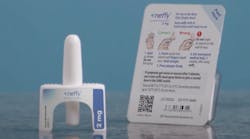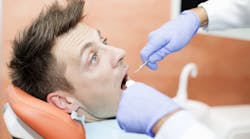Niacin and dentistry: When a simple vitamin becomes a clinical concern
When I first encountered a patient taking niacin (vitamin B3), I assumed, like many dentists might, that it was just another harmless supplement. But after consulting the Digital Drug Handbook,1 I realized that niacin is far from benign.
While this essential nutrient has profound therapeutic effects, it also has a surprising number of side effects, many of which can impact dental care. Understanding niacin’s complexities has changed how I approach patient discussions, and I hope sharing these insights will do the same for you.
Niacin’s therapeutic role
Niacin is a water-soluble vitamin found in foods such as poultry, fish, meat, and enriched grains, as well as in supplement form such as nicotinic acid or nicotinamide.2 It plays a critical role in energy production, DNA repair, and neuroprotection. A deficiency can cause pellagra, characterized by dermatitis, diarrhea, and dementia, with early signs including glossitis, weakness, and appetite loss.
Nicotinic acid, a form of niacin, has been extensively studied for its lipid-modifying effects. At high doses, it reduces LDL cholesterol and triglycerides while increasing HDL cholesterol.3 This makes it valuable for managing dyslipidemia, particularly in patients who are intolerant to statins or need additional lipid-lowering therapy.
Niacin reduces the risk of pancreatitis in hypertriglyceridemia and may lower heart attack and stroke risks in atherosclerosis. Prescription-strength niacin (more than 100 times the recommended dietary allowance) significantly impacts lipid profiles, solidifying its role in cardiovascular risk management. However, these benefits come with a significant risk of side effects.
Side effects and clinical considerations of niacin
One of the most well-known side effects of niacin is flushing, a sudden warmth and redness of the face, neck, and chest due to vasodilation and prostaglandin release.4 While harmless, it can be uncomfortable. Strategies to minimize flushing include:
- Taking niacin with food and a cool beverage
- Premedicating with aspirin (325 mg) or ibuprofen (200 mg) 30 to 60 minutes beforehand
- Switching from immediate-release to controlled-release formulations
- Gradually increasing the dose
Other common side effects include:
- headache, dizziness, vision disturbances
- cardiovascular issues (atrial fibrillation, cardiac arrhythmias, or tachycardia)
- gastrointestinal discomfort (nausea, vomiting, dyspepsia, flatulence, or diarrhea)
- dermatological reactions (dry skin, itching, or rashes)
More concerning, high doses of niacin can be hepatotoxic, leading to elevated liver enzymes or jaundice.5 This occurs particularly with long-term high doses or the sustained-release dose form. Patients with preexisting liver conditions or regular alcohol consumption are at an even higher risk and require close monitoring.
Niacin can also elevate uric acid levels, increasing the risk of gout, which is a form of arthritis that presents as rapid onset swelling, redness, and severe pain, typically affecting the joints. It can also affect glucose metabolism, leading to hyperglycemia in diabetic and prediabetic patients.
Age-related kidney, liver, or heart conditions further elevate the risk of niacin’s side effects in geriatric populations. Elderly patients may face muscle-related side effects (pain, tenderness, or weakness), orthostatic hypotension, or dizziness. Tailored dosages and regular follow-ups with kidney and liver function tests are essential to mitigate these risks.
In addition, niacin is classified as FDA Pregnancy Category C, indicating that high doses used for treating conditions such as dyslipidemia may pose potential risks to an unborn fetus and should only be used during pregnancy if it’s clearly needed.
Furthermore, niacin’s interactions with other medications should not be overlooked. When combined with statins or supplements such as red yeast rice, it increases the risk of muscle toxicity and rhabdomyolysis, a severe condition that can lead to kidney damage.
What this means for dentists
While niacin is primarily associated with cardiovascular health, it has direct implications for dental care. Oral manifestations such as glossitis, stomatitis, and xerostomia can signal niacin deficiency or side effects. Patients on niacin therapy may also experience unexplained fatigue, abdominal pain, or skin color changes, which warrant further medical evaluation.
Additionally, patients with liver disease or diabetes on niacin therapy may be at higher risk for delayed healing or increased susceptibility to infections. Being aware of a patient’s niacin use allows for better postoperative care planning and patient education.
Niacin is more than just a vitamin—it’s a powerful medication with benefits and risks. As dentists, our role extends beyond oral health; we must understand how systemic medications impact our patients. By leveraging resources such as the Digital Drug Handbook, we can stay informed, ask the right questions, and provide the best possible care.
Ultimately, being proactive about medication safety isn’t just for physicians—it’s part of being a well-rounded clinician.
References
1. The Digital Drug Handbook. MedAssentDDS. https://www.medassentdds.com/?utm_source=dentistryiq&utm_medium=affiliate&utm_name=article&utm_id=niacin
2. Niacin fact sheet. National Institutes of Health. Updated November 18, 2022. https://ods.od.nih.gov/factsheets/Niacin-HealthProfessional/
3. Song WL, FitzGerald GA. Nicacin, an old drug with a new twist. J Lipid Res. 2013;54(10):2586–2594. doi:10.1194/jlr.R040592
4. Djadjo S, Bajaj T. Niacin. Last updated March 20, 2023. https://www.ncbi.nlm.nih.gov/books/NBK541036/
5. Niacin. Last updated July 9, 2020. https://www.ncbi.nlm.nih.gov/books/NBK548176/










